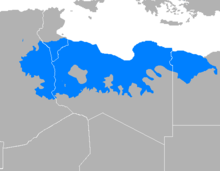Libyan Arabic
| Libyan Arabic | |
|---|---|
| ليبي | |
| Pronunciation | [ˈliːbi] |
| Native to | Libya, Tunisia, Algeria, Egypt, Niger, Chad |
|
Native speakers
|
4 million in Libya (2006) 320,000 in Egypt (2002), 5,000 in Niger (1998) |
|
Afro-Asiatic
|
|
| Arabic alphabet | |
| Language codes | |
| ISO 639-3 | |
| Glottolog | liby1240 |

Extent of Libyan Arabic
|
|
Libyan Arabic (Arabic: ليبي Lībi; also known as Sulaimitian Arabic) is a variety of Arabic spoken in Libya and neighboring countries. It can be divided into two major dialect areas; the eastern centred in Benghazi and Bayda, and the western centred in Tripoli and Misrata. The eastern variety extends beyond the borders to the east into western Egypt. A distinctive southern variety, centered on Sabha, also exists and is more akin to the western variety.
The transcription of Libyan Arabic into Latin script poses a few problems. First, there is not one standard transcription in use even for Standard Arabic. The use of IPA alone is not sufficient as it obscures some points that can be better understood if several different allophones in Libyan Arabic are transcribed using the same symbol. On the other hand, Standard Arabic transcription schemes, while providing good support for representing Arabic sounds that are not normally represented by the Latin script, do not list symbols for other sounds found in Libyan Arabic. Therefore, to make this article more legible, DIN 31635 is used with a few additions to render phonemes particular to Libyan Arabic. These additions are as follow:
Two major historical events have shaped the Libyan dialect: the Hilalian-Sulaimi migration, and the migration of Arabs from Muslim Spain to North Africa following the reconquista. Libyan Arabic has also been influenced by Italian, and to a lesser extent by Turkish. A Berber substratum also exists.
...
Wikipedia
